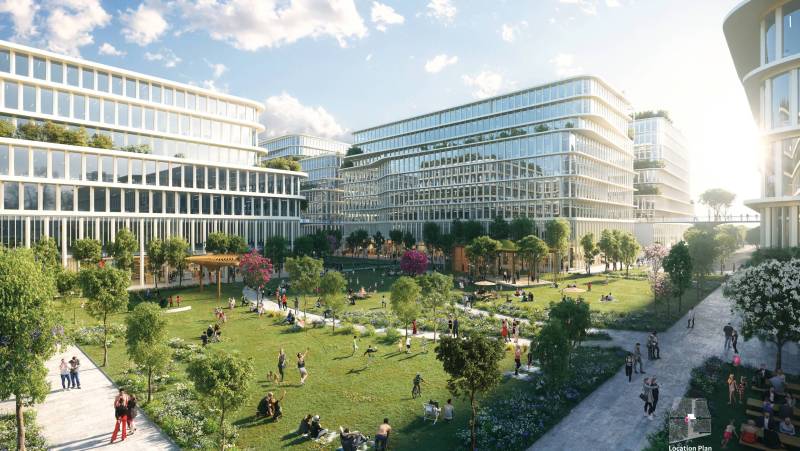The plan from Kylli, a Bay Area-based subsidiary of Chinese investment firm Genzon Group, is set to be built on a 48.6-acre site near the corner of Tasman and Old Ironsides drives, which Kylli owns and is largely made up of a parking lot currently used by Levi’s Stadium during events, along with four office buildings.
Mayor Lisa Gillmor called the project a “valuable lynchpin” toward the success of the northside during the Nov. 19 meeting where the plan was greenlit.
“This is going to bring a different dynamic to that area. Once you have residential development and the mixed-use, there’s a vibrancy that comes along with it,” Gillmor said.
While the project was supported widely by business advocates, residents and pro-housing coalitions, all the excitement may be on hold for a while.
The city and Kylli agreed to a contract that allows the developer 10 years to complete the project, with options for extending the development timeline to a total of 25 years if certain milestones are achieved or if the developer pays fees for unbuilt portions.
Santa Clara could be waiting for up to 10 years and receive nothing in return if the developer were to walk away from the project altogether, but officials are hoping the developer will follow through on its aims and say the agreement is necessary for such a large development in a rocky financing cycle.
“We can’t force it. Some people don’t understand that,” Gillmor told KQED. “When the market becomes available to finance these types of projects, believe me, they’re going to build. They will.”
Reena Brilliot, the city’s director of economic development and sustainability, said when crafting the agreement, the city had to consider that the large project would likely need to be built across multiple market cycles and that it includes a significant portion of new office space, for which there is little to no demand currently.
“We are aware that the office market is quite soft, and there isn’t a clear trajectory on when that’s going to change with remote work being still in flux,” Brilliot said.
The approval allows the developer to shrink some of its office space plans in exchange for more housing units to help boost the viability of the project and meet market demands if needed. The contract also asks the developer to build valuable community benefits first, such as 90 of the affordable apartments by 2031, and either the child care facilities or a grocery store by the 10-year mark.
If the developer meets those goals or chooses to pay a fee of $1 per square foot of unbuilt project square footage if it doesn’t, then it can request the first of three five-year extension options.
“We’re tying (the extensions) to the things that matter to us from a community benefit standpoint with the realization that they’re likely not going to build those in a standalone fashion,” Brilliot said.
Santa Clara is not new to big plans and indeed has laid out major growth blueprints all around the stadium. Just last week, the council approved the first 284 apartments of a potential 12,000 planned for a 74-acre area filled with offices that run along Patrick Henry Drive, sandwiched between Mission College and the Kylli development site.
The city’s major plans also include the Tasman East area, where some successes have already been notched. On the 45-acre plot just northeast of Levi’s, several developers are working on roughly 4,500 residential units, some of which are complete, some which are largely constructed and some are still in the pipeline, all following a 2018 plan approved by city leaders.
While the Tasman East work has moved along relatively smoothly, the city has also seen its share of unexpected delays throwing a wrench into much-ballyhooed plans for major developments.
The Related Companies, a massive New York City-based development firm, has long planned to build a landmark $8 billion project in Santa Clara directly across from Levi’s and Tasman East, known as Related Santa Clara, that was originally set to include a total of 9 million square feet of homes, offices, hotels and restaurants, all on 240-acres of city-owned land.
However, since its 2016 approval, some site work has been completed, but nothing has been built. The project faced lawsuits out of the gate from San José and later faced challenges about Related’s plan to pay workers less than prevailing wages, and requires careful environmental planning because much of it is being built on a former landfill site.
It has also contended with the same market forces shifting other projects. Related was able to secure nearly $700 million in financing to build two projects in the Tasman East area in recent years.
Challenges aside, some leaders have grown frustrated with the lack of construction over eight years for the large project, especially because of the developer’s size.

